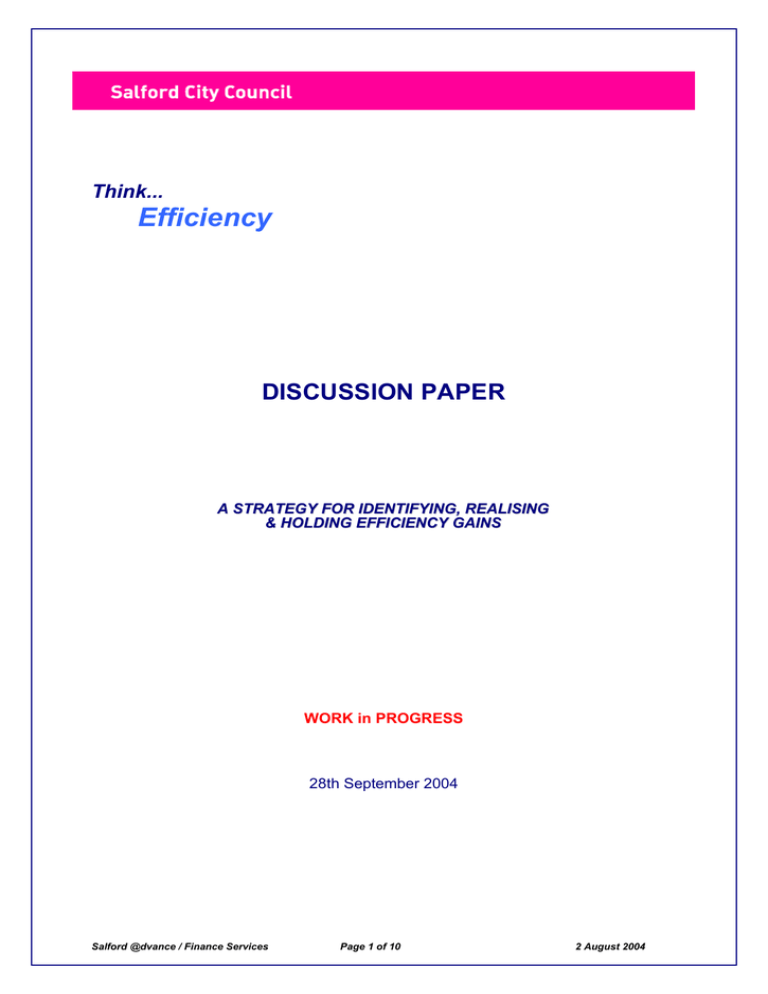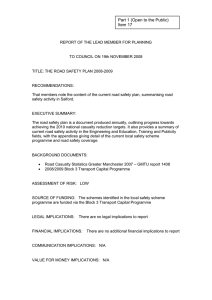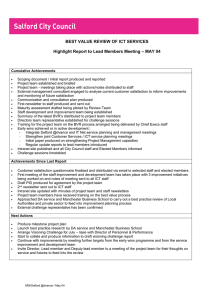Efficiency DISCUSSION PAPER Think...
advertisement

Think... Efficiency DISCUSSION PAPER A STRATEGY FOR IDENTIFYING, REALISING & HOLDING EFFICIENCY GAINS WORK in PROGRESS 28th September 2004 Salford @dvance / Finance Services Page 1 of 10 2 August 2004 CONTENTS Section Page No. 1. Introduction 3 2. About the Gershon Report 3 3. Efficiencies in the City Council 4 4. Context 5 5. The Efficiency Imperative 5 6. Aims 7 7. Current Work Plans 7 8. Future Approach 9 9. Next Steps Salford @dvance/ Finance services 10 Page 2 of 10 2 August 2004 1. Introduction The City Council have recently embarked on a major strategy to improve the performance, accessibility, responsiveness and integration of front line services to Citizens, through a collaborative service model, both within the council and with partners, under the name: Think Customer This document compliments that strategy by setting out an initial set of ideas within a consolidated programme of measures aimed at improving overall council-wide organisational efficiency. These as a means of delivering up savings in line with the provisions of the Gershon Report (July 2004), in an endeavour to free up resources to be redirected towards front office services and so facilitate implementation of the Think Customer Strategy and to meet budget savings targets required to keep expenditure within resources available We have chosen the title Think Efficiency as the name for an overarching strategy for identifying, implementing and embedding such efficiency measures The opportunity has been taken to bring together existing and planned efficiency initiatives throughout the council into a single picture for clarity and better strategic management In summary then, this report does 4 things: 1. Reflects on the main points of the Gershon Report and interprets them as they relate to the council 2. Provides some initial thinking on an overarching framework for addressing the drive for efficiency gains within context of the wider strategic change agenda and existing work plans within the Council 3. Sets some high level efficiency aims for the council over the period 2004/5 to 2007/8 4. Sets out a future approach and next steps to create the necessary capacity, momentum and governance 2. About the Gershon Report The Gershon Report produced for Central Government entitled: Releasing Resources to the Front-line (July 2004) sets out a range of proposals to achieve substantial efficiencies within the public sector and so enable the redirection of resources to front line services or else take the efficiencies as cost savings A definition of efficiency is provided in the report, as a starting point for their review proposals. These are restated below together with a brief note of how they translate to Salford’s setting: Gershon What it means for Salford Reduced numbers of inputs (people or assets), whilst maintaining the same level of service provision. Reducing the staff effort or making better use of things such as information systems and accommodation in delivering the same quality and quantity of services Lower prices for resources needed to provide public services Negotiating lower prices for bought in goods and services through improved procurement measures Additional outputs such as enhanced quality or quantity of service, for the same level of inputs Improved ratio of output per unit cost of input Changing the balance between different outputs aimed at delivering a similar overall objective in a way which achieves a greater overall output for the same inputs Salford @dvance/Financial Services Working smarter, improving processes, rationalising structures for economies of scale. Changing service design for new ways of working or new service offerings to achieve same overall goals. Exploiting technologies for improved performance with the same or less resources or achieving a step change in performance with relatively small increase in resources Page 3 of 10 29th September 2004 The report identifies six main potential areas for savings (or work-streams): Work Stream Activity/Service What it means for Salford Back Office Functions, which provide essential support to the delivery of front-line services, eg. Finance, HR, ICT, legal, marketing Reviewing support services provided both at the `centre’ and in directorates Procurement Purchase of goods and services Adopting a Procurement strategy and reviewing procurement practices Transactional Services Performing the day-to-day service transactions to citizens, e.g. paying benefits, collection of taxes, exchange of information such as births and deaths Reviewing cost effectiveness of transactional services Policy, funding and regulation… for public sector Ensuring regulatory and funding roles are proportionate to the value added Reviewing our regulatory and funding role Maximising the time spent on actually delivering front line services to citizens versus engagement on supporting back office activities Reviewing involvement of front line professionals in administrative tasks Policy, funding and regulation… for private sector Productive time of front-line service professionals 3. Efficiencies in the City Council Clearly, substantial and creative efficiency gains are not novel within the council. The following analysis highlights just some of the notable improvements over recent years: Service Area Initiative Impact Finance Re-engineering of financial processing services supported by replacement of LAFIS with SAP Improved service and reduced transaction costs Customer Services Implementation of document management for council tax and benefits Improved service and lower service costs Introduction of corporate contact centre Improved service to citizens, lower transaction costs Improved service and lower costs Improved service and lower costs Community and Social Services Environmental services Re-engineering of home care service from wholly in house to mixed economy Re-engineering of refuse collection and street cleaning ICT Services Renegotiation of hardware and software contracts, altered mix of equipment Lower cost of ownership, improved performance and reliability of infrastructure This is a firm foundation on which to build a future consolidated programme of measures to hold the gains and create new initiatives – but first, let us consider how we might view the overarching approach to future thinking, planning and delivery of a Think Efficiency strategy. The next sections outline such a framework, embracing process, organisation and systems considerations within context of the focus on front line improvements. Salford @dvance/Financial Services Page 4 of 10 29th September 2004 4. Context The Think Efficiency Strategy works in close unison with Think Customer. Think Customer strategy aims to improve front line process efficiencies and share information for cost savings. Think Efficiency strategy aims to generate cash saving / liberate resources for re-allocation to Think Customer Think Customer £££ Think Efficiency Fig.1 complimentary nature of Think Customer & Think Efficiency 5. The Efficiency Imperative The most effective way of developing and handling a Think Efficiency strategy is by way of a number of interrelated key building blocks, working in tandem in order to provide a coherent overarching strategic framework for action: Capacity building Leadership and Governance Business model & structure Performance setting & management Culture Efficiency imperative Processes & transactions Skills & Knowledge management Resources, Partners & suppliers Fig.2 Strategic framework – 10 key building blocks Systems & Tools Consultation & communication The scope of each of one of these key building blocks is explained below: Salford @dvance/Financial Services Page 5 of 10 29th September 2004 Leadership and Governance Ensure effective leadership and governance arrangements of a consolidated efficiency strategy in order to provide the vision, drive, challenge and management of results Business model & structure Service re-design for the optimum mix of corporate / localised process management arrangements, structure and collaborative working for achievement of economies of scale. Proposals will take account of proposed corporate structure and planned shared service function Culture Foster a culture of innovation and continuous improvement to identify develop and implement improvement opportunities and hold the gains. Initial focus will be on answering the question: are we fully exploiting good practice already in place? Processes & transactions Systems & Tools Resources, Partners & suppliers Expand ongoing efforts to re-engineer front line transactions and back office processes including procurement Ensure wide access and effective use and take-up of personal and team based productivity tools and facilities based on standardised product set Ensure budget allocation process rewards high performance and achievement of target outcomes and penalises poor performance. Devise resource management and resourcing models through Centres of Excellence and Partnering Skills & Knowledge management Expand and accelerate Skills development and knowledge management programmes geared to efficient process management Performance setting & management Ensure setting of challenging success criteria and performance targets aligned to local and national priorities and establish effective benefits realisation and benchmarking capabilities, supported by ICT systems Capacity building Consultation & communication Provide the necessary day-to- day practical mentoring and support to guide, assist and embed efficiency changes throughout council, including spreading of best practice Put in place effective communication and consultation to engender commitment and engagement to strategy Salford @dvance/ Finance services Page 6 of 10 2 August 2004 6. Aims (1) To define value of overall target savings, which are… `Cashable’ arising from productivity gains For budget savings or re-directing to support front line service improvements (2) To articulate targets in terms of reducing transaction costs (of x core processes) or reducing the level of overheads to xxx % of gross expenditure, which more closely aligns with best performing organisations by 2007/8 (3) Developing a council – wide programme of measures to address the above targets (4) Developing suitable methods and techniques for quantifying and driving in the targets benefits and savings (5) To position the Council to be able to respond positively to any demands from Government for efficiencies (6) To ensure that efficiencies will result in services that give value for money 7. Current Work Plans Resource Planning Group and Directors Team have considered and endorsed an early draft of this paper and undertaken an initial piece of work to identify high level proposals whereby efficiency savings may be made over the next 3 years. The following tables represent areas of activity where it is believed efficiencies can be made. Cross-Cutting Proposals Service Area Payroll/HR Orders/Invoices Energy Property PSA reward grant Efficiency proposal More automation of processes and shared service centre based around maximising SAP utilisation Streamlined processes through eprocurement, reduced paperbased transactions, purchasing cards to maximise SAP utilisation Efficiencies from conservation measures and scrutiny of charges Reduce through service change, flexible office culture, eg drop-in centres, electronic “hub” working, standardisation in office furniture, sharing with partners One-off usage for saving Salford @dvance/ Finance services Page 7 of 10 Cashable Productivity Saving Gain Yes Yes Yes Yes Yes No Yes Yes Yes No 2 August 2004 Corporate Corporate Corporate Corporate Corporate Corporate Corporate Procurement Procurement Procurement Procurement SLAs HR HR HR HR ICT Themes for all directorates “Think Customer” initiative Strategic review Support services generally in service and central directorates – process map to identify duplication /unnecessary processes and maximise the use of support services by reviewing admin tasks performed by front-line staff Project management – dedicated multi-disciplinary task force – saving on training, lost time, increased expertise – capacity building Review public consultation techniques Rationalise/combine directorate strategy & policy units Maximise private sector and grant income (with particular focus on S106 agreements) Insisting on use of corporate contracts – penalise maverick spending Engagement of consultants – develop guidelines to rationalise their usage Agency staff – contract for admin & clerical staff jointly with PCT & other partners Regional contracts via centres of excellence Reduce administration by stopping or doing differently Adopting good practice, inc partnership working Rationalise training facilities and equipment – have a single designated authority training location (this should be the Eccles LIFT Centre in partnership with PCT) Improve attendance management Review potential for economies of scale for administrative and clerical support arising out of the Strategic Review Replacement programme using standardised products No Yes Yes Yes Yes Yes Yes Yes No Yes Yes Yes Yes No Yes Yes Yes No Yes Yes Yes Yes Yes Yes Yes Yes Yes Yes Yes Yes Yes Yes Yes Yes Partnership working generally Procurement Income generation Yes Yes Yes Yes Yes Yes Salford @dvance/Financial Services Page 8 of 10 29th September 2004 Expected to realise a minimum of £100,000 cashable saving or 10% productivity gain over 3 years Directorate Corporate Services Corporate Services Corporate Services C & Social Servs C & Social Servs C & Social Servs C & Social Servs Environ’l Servs Environ’l Servs Develop’t Servs Develop’t Servs Develop’t Servs Chief Executive Housing Efficiency proposal Software licences Cashable Productivity Saving Gain Yes No Printing – market the service better Yes No Reduce front-of-house staff in Phase 3 Yes Yes Expanded use of palm-top and wireless No technology E-procurement of care services No Yes Home care brokerage No Yes Transport Yes No Light vehicle fleet tender (may be < £100k) Rationalisation of waste collection JVC – annual 2.5% efficiency savings target Rethinking construction costs – reducing construction costs, supply chain management & tendering administration Benefit from Capita’s purchasing power Marketing & communication benefits (income generation) Stock options appraisal Yes ? No Yes Yes Yes Yes Yes (Rev & Cap) Yes Yes Yes Yes No Yes Yes Yes 8. Future Approach Governance… is proposed through the Lead Member for Corporate Services, acting as focal point, through whom political decisions will be sought, in conjunction with Cabinet and Budget Strategy Group as appropriate Day to Day progress and management… through the Resource Planning Group in conjunction with Directors’ Team as appropriate Decision Conferencing… would provide the practical vehicle for identifying and distilling ideas for incorporation into a consolidated programme Project Teams… would be established to pursue individual areas of investigation and implementation, within an overall council wide programme Salford @dvance/Financial Services Page 9 of 10 29th September 2004 9. Next Steps Prepare a detailed scoping document for each efficiency proposal within the context of each of the ten key building blocks described in section 5, which provides a better understanding of how the high level proposals can be translated into realisable efficiency gains, and the timescales for delivery. Identify the resource implications associated with the delivery of the efficiencies To prioritise the efficiency proposals in order to ensure that the maximum gains are achieved in the shortest possible time To develop methodologies for quantifying efficiency gains which are non-cashable To develop methodologies for assessing value for money. Salford @dvance/Financial Services Page 10 of 10 29th September 2004


